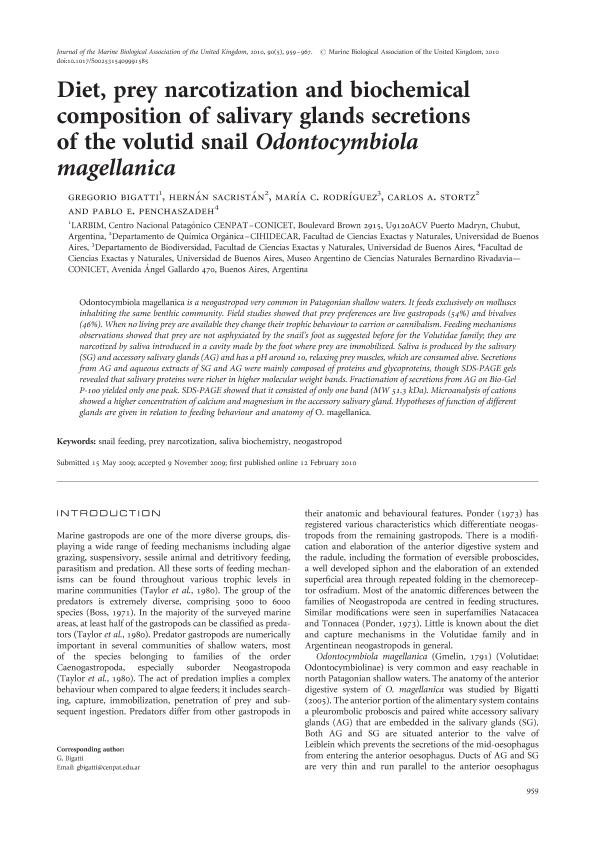Artículo
Diet, prey narcotization and biochemical composition of salivary glands secretions of the volutid snail Odontocymbiola magellanica
Bigatti, Gregorio ; Sacristán, Hernán Javier
; Sacristán, Hernán Javier ; Rodríguez, María Cecilia; Stortz, Carlos Arturo
; Rodríguez, María Cecilia; Stortz, Carlos Arturo ; Penchaszadeh, Pablo Enrique
; Penchaszadeh, Pablo Enrique
 ; Sacristán, Hernán Javier
; Sacristán, Hernán Javier ; Rodríguez, María Cecilia; Stortz, Carlos Arturo
; Rodríguez, María Cecilia; Stortz, Carlos Arturo ; Penchaszadeh, Pablo Enrique
; Penchaszadeh, Pablo Enrique
Fecha de publicación:
08/2010
Editorial:
Cambridge University Press
Revista:
Journal of the Marine Biological Association of the United Kingdom
ISSN:
0025-3154
Idioma:
Inglés
Tipo de recurso:
Artículo publicado
Clasificación temática:
Resumen
Odontocymbiola magellanica is a neogastropod very common in Patagonian shallow waters. It feeds exclusively on molluscs inhabiting the same benthic community. Field studies showed that prey preferences are live gastropods (54%) and bivalves (46%). When no living prey are available they change their trophic behaviour to carrion or cannibalism. Feeding mechanisms observations showed that prey are not asphyxiated by the snail's foot as suggested before for the Volutidae family; they are narcotized by saliva introduced in a cavity made by the foot where prey are immobilized. Saliva is produced by the salivary (SG) and accessory salivary glands (AG) and has a pH around 10, relaxing prey muscles, which are consumed alive. Secretions from AG and aqueous extracts of SG and AG were mainly composed of proteins and glycoproteins, though SDS-PAGE gels revealed that salivary proteins were richer in higher molecular weight bands. Fractionation of secretions from AG on Bio-Gel P-100 yielded only one peak. SDS-PAGE showed that it consisted of only one band (MW 51.3 kDa). Microanalysis of cations showed a higher concentration of calcium and magnesium in the accessory salivary gland. Hypotheses of function of different glands are given in relation to feeding behaviour and anatomy of O. magellanica.
Palabras clave:
Neogastropod
,
Prey Narcotization
,
Saliva Biochemistry
,
Snail Feeding
Archivos asociados
Licencia
Identificadores
Colecciones
Articulos(CCT-CENPAT)
Articulos de CTRO.CIENTIFICO TECNOL.CONICET - CENPAT
Articulos de CTRO.CIENTIFICO TECNOL.CONICET - CENPAT
Articulos(CIHIDECAR)
Articulos de CENTRO DE INVESTIGACIONES EN HIDRATOS DE CARBONO
Articulos de CENTRO DE INVESTIGACIONES EN HIDRATOS DE CARBONO
Articulos(MACNBR)
Articulos de MUSEO ARG.DE CS.NAT "BERNARDINO RIVADAVIA"
Articulos de MUSEO ARG.DE CS.NAT "BERNARDINO RIVADAVIA"
Citación
Bigatti, Gregorio; Sacristán, Hernán Javier; Rodríguez, María Cecilia; Stortz, Carlos Arturo; Penchaszadeh, Pablo Enrique; Diet, prey narcotization and biochemical composition of salivary glands secretions of the volutid snail Odontocymbiola magellanica; Cambridge University Press; Journal of the Marine Biological Association of the United Kingdom; 90; 5; 8-2010; 959-967
Compartir
Altmétricas



